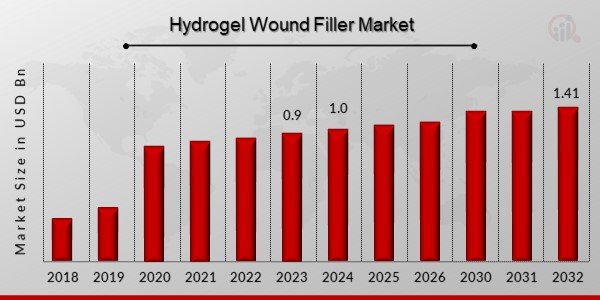June 29, 2024
New York, NY (Highpoint Digest) − The hydrogel wound filler market is estimated to register a CAGR of 5.00% during the forecast period of 2024 to 2032.
MRFR recognizes the following companies as the key players in the global hydrogel wound filler market – 3M (US), Molnlycke Health Care Ab (Sweden), Convatec Group Plc (UK), Advanced Medical Solutions Group plc (UK), Paul Hartmann AG (Germany), DeRoyal Industries (US), Coloplast A/S (Denmark), Cardinal Health, Inc. (US), and Derma Sciences (US).
Market Highlights
The global hydrogel wound filler market is accounted to register a CAGR of 5.00% during the forecast period and is estimated to reach USD 1.41 billion by 2032.
During the forecast period, the global hydrogel wound filler market is expected to grow due to a number of factors, including an aging population, improving healthcare infrastructure, an increase in government initiatives aimed at raising patient awareness about diabetes diagnosis and treatment, ulcers, and a significant focus on providing cost-effective products to improve patient outcomes and increase the number of unintentional cases of burn injuries.
Segment Analysis
The global hydrogel wound filler market has been segmented into product and wound type.
On the basis of product, the market is segmented into Amorphous Hydrogel Dressings, Impregnated Gauze, Hydrogel Sheets, and Other Products. The amorphous hydrogel dressings segment was attributed to holding the largest market share in 2023. An amorphous hydrogel dressing is applied to moisten a dry wound and provide a wet healing environment. Common applications for these bandages include healing radiation-damaged tissue, mild burns, and necrotic wounds. It is anticipated that the need for hydrogel wound filler will rise in light of the rise in the number of burn victims worldwide.
Based on wound type, the global hydrogel wound filler market has been segmented into Surgical & Traumatic Wounds, Diabetic Foot Ulcers, Pressure Ulcers, Venous Leg Ulcers, Burns, and Other Wounds. The diabetic foot ulcers segment was expected to hold the largest market share in 2023. The primary reason for the growth in sales of hydrogel wound filler products is to treat diabetic foot ulcers. Studies have indicated that approximately 13.5 million people worldwide are thought to have diabetic foot ulcers. Further contributing to the increased demand for the items is the fact that these ulcers heal more slowly and need to be treated more frequently.
Regional Analysis
The global hydrogel wound filler market, based on region, has been divided into North America, Europe, Asia-Pacific, and Rest of the World. North America consists of the US and Canada. The Europe hydrogel wound filler market comprises of Germany, France, the UK, Italy, Spain, and the rest of Europe. The hydrogel wound filler market in Asia-Pacific has been segmented into China, India, Japan, Australia, South Korea, and the rest of Asia-Pacific. The Rest of the World hydrogel wound filler market comprises the Middle East, Africa, and Latin America.
The North American regional sector maintained the largest market share for hydrogel wound filler because of an aggressive strategy for better wound care, a strong healthcare infrastructure, and technological innovation. When treating long-term illnesses like diabetes and obesity, they emphasize patient outcomes and the standard of therapy.
Moreover, the Europe market has been persistently growing over the forecast period, ascribed to the rise in obesity and chronic illnesses brought on by altered lifestyles. Additionally, because people with diabetes are more likely to acquire chronic wounds, it is anticipated that the expanding diabetes population would raise demand for hydrogel wound filler supplies in this sector. Moreover, one of the main drivers of market expansion in the area is the existence of major companies.
Additionally, Asia Pacific is anticipated to experience the quickest growth over the forecast period because of the increased use of hydrogel wound filler products and increased knowledge about hydrogel wound filler. In addition, the region’s market is growing because of the increased prevalence of chronic illnesses, high disposable income, and developments in the healthcare industry.
Furthermore, the rest of the world’s hydrogel wound filler market is divided into the Middle East, Africa, and Latin America. The lack of qualified medical personnel and the demand for hospitals with cutting-edge medical facilities are driving growth in the hydrogel wound filler market in LAMEA. Furthermore, the growing prevalence of diabetes and ulcers in LAMEA encourages the use of hydrogel wound filler services, which in turn propels market expansion.
Key Findings of the Study
-
- The global hydrogel wound filler market is expected to reach USD 1.41 billion by 2032, at a CAGR of 5.00% during the forecast period.
-
- The Asia-Pacific region accounted for the fastest-growing global market due to the growing awareness of hydrogel wound filler and the usage of hydrogel dressing products.
-
- Based on wound type, the diabetic foot ulcers segment was attributed to holding the largest market in 2023, with an approximate market share of 45%.
- 3M (US), Molnlycke Health Care Ab (Sweden), Convatec Group Plc (UK), Advanced Medical Solutions Group plc (UK), Paul Hartmann AG (Germany), DeRoyal Industries (US), Coloplast A/S (Denmark), Cardinal Health, Inc. (US), and Derma Sciences (US) are the key market players.
Source: Market Research Future
Image courtesy of Market Research Future



